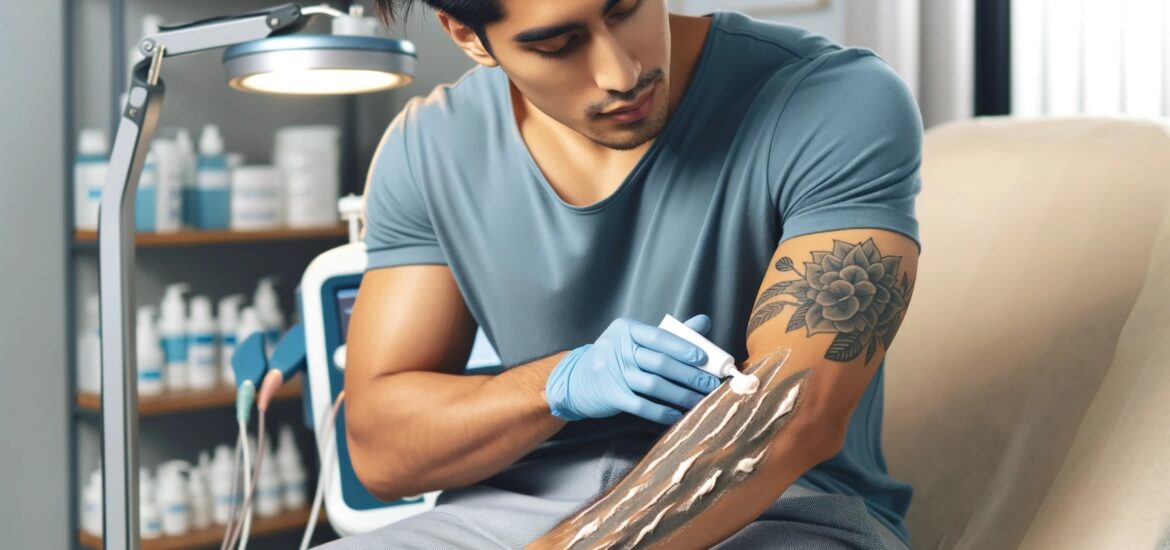Follow this comprehensive guide to learn how to treat a tattoo after laser removal with confidence.

Table of Contents
How to Treat a Tattoo After Laser Removal: Immediate Care
The first few hours after laser tattoo removal are crucial for the healing process. It’s important to follow these detailed steps:
Leave the protective bandage that your technician applied on for at least three hours after the procedure. This bandage helps shield the sensitive skin from bacteria and other contaminants.
Before touching the treated area, ensure your hands are clean to reduce the risk of infection. Use a handwashing technique recommended by health authorities, which includes washing with soap and water for at least 20 seconds.
Gently remove the bandage without pulling at your skin. If it sticks, you can moisten it slightly with lukewarm water to help it release.
Using a hypoallergenic or fragrance-free soap, clean the area carefully. Do not use hot water or harsh scrubbing motions, as this can irritate the skin. Instead, gently lather with the soap and rinse by allowing water to flow over the area. (Source)
After cleansing, pat the area dry with a disposable paper towel or a freshly laundered cloth towel. Avoid rubbing as this can aggravate the skin.
Apply an ointment recommended by your technician, like aloe vera or an antibiotic ointment, to help soothe and protect the area. Use a clean applicator or a clean fingertip to spread a thin layer over the skin.
Cover the area again with a sterile bandage or gauze. Change this dressing at least once a day or as advised by your technician to maintain cleanliness.
For the next three days, clean the treated area two to three times a day and reapply the ointment before re-bandaging. This consistent care is essential to prevent the development of infections and to facilitate optimal healing.
Managing Swelling and Discomfort
Swelling and discomfort are common reactions following laser treatment. Here’s how to manage them:
Use a clean, cloth-wrapped ice pack or a bag of frozen vegetables wrapped in a towel and apply it to the affected area. The cold helps reduce inflammation and numb the discomfort. Remember never to apply ice directly to your skin as it can cause frostbite. (Source)
If you’re experiencing pain, over-the-counter pain relievers like acetaminophen can be taken. Follow the instructions for dosage on the package and avoid medicines that may promote bleeding, such as aspirin or ibuprofen, unless your doctor specifically permits them.
Keep the treated area elevated above the level of your heart as much as possible, especially in the first 24 hours. This can help reduce swelling. For example, if the tattoo was on your ankle, lie down and prop it up on pillows.
Reference: Mayo Clinic
Avoiding Infection and Complications
Protecting the treated area from infection and further complications is essential. Follow these precautions:
Avoid touching the treated area with unwashed hands. When you do touch the area for cleaning or applying ointment, ensure your hands are thoroughly washed each time.
Scabs and blisters can form as part of the healing process. Do not pick at scabs or pop blisters, as doing so can introduce bacteria, lead to scarring, and slow down the healing process.
Keep the treated area dry except when cleaning. If it gets wet (e.g., due to sweating), pat it dry gently with a clean towel or paper towel.
Avoid swimming, soaking in tubs, and activities that can submerge or soak the treated area until it is fully healed.
Monitor the healing process daily. If you notice any signs of infection—such as increased redness, warmth, swelling, pus, or if you develop a fever—contact your healthcare provider immediately.
Long-Term Skin Care
After your skin has initially healed, long-term care is vital for maintaining its condition. Here’s what you should do:
Continue to moisturize the area daily with a fragrance-free, hypoallergenic lotion like the Curel Fragrance Free Lotion available at Walmart. This helps maintain the skin’s elasticity and prevent peeling.
Apply a high-SPF, broad-spectrum sunscreen to the treated area before going outside. This helps prevent hyperpigmentation (darkening) and protects against sun damage.
You can get this Banana Boat Sport Ultra SPF 50 Sunscreen Lotion from Walmart.
Opt for loose, breathable clothing to avoid friction on the treated area, which could cause irritation and discomfort.
Check out these other articles…
How to Treat Skin After Laser Tattoo Removal: Essential Tips
Does Skin Go Back to Normal After Laser Tattoo Removal?
What Causes Blisters After Laser Tattoo Removal? Easy Answer
Should You Pop Blisters After Laser Tattoo Removal? Answered
How to Prevent Blisters After Laser Tattoo Removal: Pro Tips
When to Seek Medical Advice
If you experience any of the following symptoms during the healing process, it’s important to seek medical advice promptly:
Increased pain in the treated area that does not improve with over-the-counter medication.
Redness, warmth, or swelling that expands beyond the tattoo site.
Fever, which can be a sign of infection.
Unusual discharge or a foul odor coming from the treated area could indicate an infection.
Any other symptoms that seem abnormal or cause you concern. Trust your instincts—if something feels wrong, it’s better to consult with a professional.


